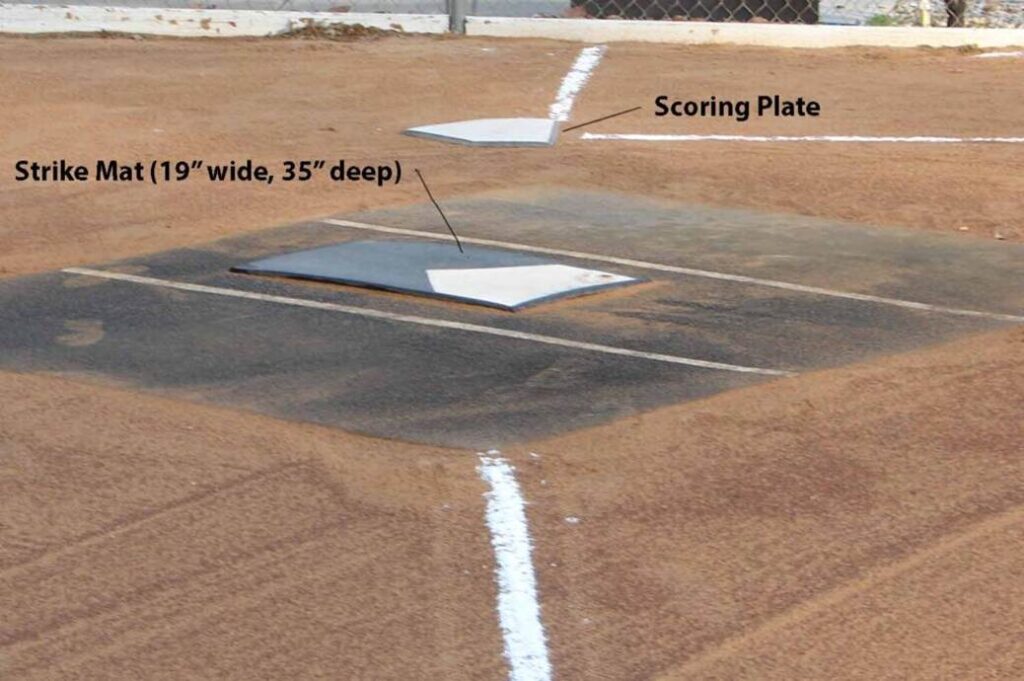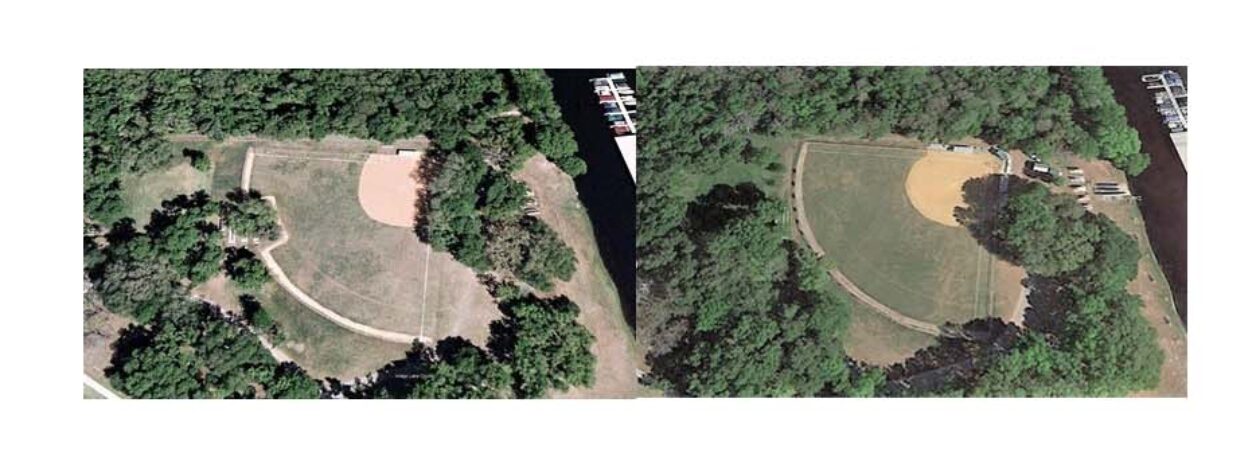by Jim Herbert
SENIOR SOFTBALL GUIDE
by Jim Herbert
If you’ve attended a Hawthorne Softball game (and shame on YOU if you haven’t) or if you’re a new player, you would have noticed that “senior softball” is a bit different than the baseball and softball games you’ve played or watched.
Changes have been made to the game to “accommodate” it to the needs and abilities of 55+ players; that “plus” can extend for quite a few years. Our players’ ages range from mid-50’s to 80 plus.
The game we play is designed to make it safer and more practical for “age-challenged” players.
The most obvious change is the number of players on defense. “Traditional” baseball and softball have nine players on defense – a pitcher, a catcher, three outfielders and four infielders. Senior Softball has FOUR outfielders (left, left center, right center, and right fielders.) We also insert an infielder between the second baseman and the shortstop who is referred to as the MID FIELDER or ROVER.
The added players make up for the fact that SOME of us are slower afoot and don’t have the reflexes of 20-year old’s (or 50-year olds, for that matter.)
In the traditional game only the players who have fielding positions can bat. In Senior Softball, any number of players from the team roster may BAT during the game. They do NOT have to play positions on the field. (The inverse is not true, though. A player NOT in the batting order CANNOT play in the field.)
Our style of ball is called “slow pitch.” That means that the pitcher attempts to LAND the ball on a 19 x 35 inch “strike board”. If the pitched ball hits this board before being struck by the batter, it is a “called” strike.

The pitch must be thrown underhand and travel from the pitcher to the strike board in an “arc”. At its HIGHEST POINT, the pitch can be no lower than 6 feet and no higher than 12 feet off the ground. If you hear the umpire say “illegal”, that means the pitch was outside the 6 to 12-foot limits and is an automatic “ball”. (Some umpires will say “high”, “low” or “flat” for an illegal pitch.) A batter MAY swing and hit an illegal pitch. A “swing and a miss” is ALWAYS a strike.
One rule that may seem odd to a spectator is that if a player with two strikes hits the ball into foul territory, it is a “strike out”. In most other kinds of baseball/softball, a player can foul off an unlimited number of pitches with two strikes. In Senior Softball, ALL foul balls are strikes.
There is discussion among the league’s leadership to begin every at bat with a “one and one” count. That is, every batter will start with one ball and one strike. It is hoped that this will speed up games. This will be determined at the finally League Meeting just before league play begins on November 4.
At Hawthorne, ALL pitchers must use a screen placed between the batter and the pitcher; its purpose is to protect the pitcher from hard hit balls. This screen is approximately 3 feet wide and 6 feet tall. It is placed 4 feet in front of the “pitcher’s rubber” so that half the rubber is behind the screen. A hit ball that touches this screen is a “dead ball”, neither strike nor ball. Any THROWN ball that hits the screen is still in play.
The pitcher MUST get behind the screen before the pitch reaches the batter. There are a variety of consequences for not doing this, ranging from a warning from the umpire to being barred from continuing as the pitcher.
The old saying among aging baseball players is that “the legs are the first thing to go.” In Senior Softball, where the “legs going” is the LEAST of our problems, another player from the batting order can be used as a “courtesy runner”, either substituting for a player already on base OR running for the batter from home plate.
If a courtesy runner is used for the batter, he/she starts 8 feet back from the third base line (5 feet back for women) and runs to first from there. There is a chalk line drawn behind home plate that serves as a starting line. There’s another chalk line approximately halfway between home plate and first base. If BOTH the batter and the courtesy runner start to run to first, the BATTER must stop before crossing this line or be called out.
The courtesy runner must be in the batting order. When a courtesy runner replaces another player, both players may still stay in the game.
Senior softball does not allow intentional bunting or slapping the ball (as you might see in a high school or collegiate “fast pitch” softball game.) Given the limited mobility of some of our pitchers and catchers, this is a SAFETY issue!
There’s no base stealing in Senior Softball. A runner may not leave the base until the pitch reaches the batter.
When you attend a game, you’ll probably notice that there are TWO first bases and two “bases” at home*.

At first base, there is a white base in the regular location. There’s also a RED base next to it, in foul territory. When there’s a “play” at first, the fielder must step on the white base and the runner must step on the red base. This is intended to minimize collisions and may result in runners who seem to be safe being called “OUT” or runners who seem to be thrown out being called “SAFE”.
A similar situation occurs when a runner is trying to score. The pitcher’s plate (the 19 x 35 “strike plate” – see first image, above) must be touched by the catcher when the ball is caught for the runner to be out. The runner must cross the chalk line running at a right angle to home plate – the scoring line (this line has now replaced the “base”). The runner’s foot must touch or cross this line to score a run. The catcher is not allowed to tag the runner at or around home plate. ALL outs at home are “force outs”.
If the player running to home touches the batter’s area (carpet covered and outlined in white), it is an automatic out.
Tagging a runner is rarely necessary in Senior Softball. All plays are force outs. For example, a runner from second does not need to be tagged as he/she approaches third even if there’s no one on first. If the runner doesn’t stop, the fielder just needs to touch third base to FORCE the out. If the runner STOPS, they can be forced to return to second. The fielder on second, upon catching the ball, can touch that base to force the out. The runner cannot reverse direction again. There are NO RUN-DOWNS in Senior Softball.
We usually play 8 inning games. Teams are only allowed to score 5 runs in any one inning. Only in the 8th inning (or “extra innings”) are teams allowed to score unlimited runs.
A rule in the Sun and Fun League automatically ends a game if a team is 15 or more runs ahead after the 5th inning. This is referred to as the “mercy rule”. (NOTE: the “mercy rule” is looked at and revised by the league every year.)
So, that’s it. You still need three strikes for a strike out and four balls for a walk. There’s still 3 outs in an inning. You still have to touch all the bases to score a run*.
If you come and watch one of our games, you’ll still see spectacular defensive plays and heartbreaking fielding errors. You’ll see power hitting and weak pop ups, wicked line drives and singles that roll 3 feet from home plate. In other words, it’s not just a lot of old folks trying to re-live their youth! You’ll get to see a great BALL GAME.
* New rule (Sun And Fun League only) beginning with the 24-25 season. On an over-the-fence homerun, runners – including the hitter – do NOT have to touch the next base.
9/30/18, revised 9/18/25.
